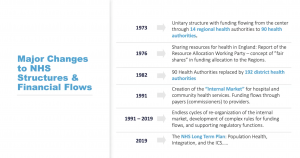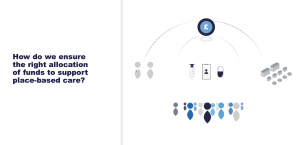Driving ICS value by the effective use of payment mechanisms
20 November 2020

Realising the value promise of integrated care systems (ICSs) is probably the biggest transformation challenge the NHS in England has faced since the publication of Working for Patients in 1991.
This initiated a radical governance redesign; it saw the creation of the ‘internal market’, which has characterised the operating model of the NHS in England for 30 years. The creation of payers (commissioning) and independent care providers was designed to incentivise efficiency improvements, decentralise, increase provider responsiveness, and improve accountability, management information and ‘customer service’.[1]
We have seen many reorganisations of the internal market since 1991. Change fatigue means there is now little appetite for further reorganisation. However, there is a need for radical change in the way system members collaborate if we are to deliver solutions to the deep and long-standing challenges that were arguably exacerbated by the internal market.
On top of responding to the COVID-19 pandemic, there is much work to be done to improve health, reduce health inequalities, mend fragmented service pathways, and improve system efficiency and effectiveness.
Despite recent funding settlements, there is and will remain little financial headroom, even at a system level, to fund the changes we need. A key step on this journey will therefore be to think again about how funding should flow through the system and ultimately how we ensure money is available to pay for the right resources in the right place at the right time.

Moving away from tariff-based payments
In recent months, turbocharged by COVID-19 pressures, we have seen a dramatic move away from the tariff-based payment mechanisms that have characterised the hospital and community healthcare internal market for the last 17 years.
Tariff-based payments were introduced to drive volume growth, specifically as a means of dealing with the prevailing problem of long waiting lists. However, it became clear that ‘payment by results’ might result in an over-reliance on hospital care, did little to reward quality and outcomes, and hindered investment in more efficient and effective prevention programmes and community-based care. This resulted in a wider, deeper and increasingly sophisticated system of payment models and corrections to incentivize performance.
Since March 2020 that has all gone, as has the associated immense administrative burden. The pandemic has seen an accelerated move to financial performance being monitored at system level, with commissioning budgets aggregated for the ICS. For hospital and community healthcare providers, there has been an immediate move to block contracts based on rolling costs.
NHS England is shortly due to announce the results of a consultation on payment models for the coming cycle and it is expected to endorse aligned incentive contracts for next year, combining a fixed, variable and risk share element supported by an appropriately blended payment system.
The transition to a new payment system for ICS has happened faster than anyone anticipated at the start of the year – and there will be no going back.
ICSs should not just be interested in funding flows for hospital and community health services; their goals are also linked to the role and quality of primary care, public health and related expenditure, and social care funding. Indeed, there has been inadequate investment in prevention, inequity of access for vulnerable populations, and fragmented care pathways. These are potentially exacerbated by a lack of alignment between funding flows for hospital and community health services and those partner agencies and providers that play a pivotal role in achieving population health goals and integrated health and care delivery.
There remains much discussion about a longer-term move towards a population health approach supported by value-based payment models, but the search for the payment model nirvana continues.
What drives the choice of one payment mechanism over another?
Looking at how payment mechanisms are designed around the world there are five core design principles:
- Needs: where money is distributed according to the size of the population need and associated costs arising from the impact or illness impact of an annual incidence or overall prevalence of a disease, or the perceived risk of a disease, or risk of injuries. Capitation is an example of a payment system designed to address need and relative need.
- Capacity: where money is distributed according to the number, types and costs of inpatient beds or the numbers and costs of clinicians in a hospital or a primary or community outlet. Examples here include global budgets, line item budget (often enshrined in ‘block’ contracts).
- Activity: where money is used to cover the costs of the number of patients admitted or discharged, the number of patients operated on, and/or the amount, type and costs of medicines administered. This can include fee-for-service payments, price per episode, or case-based payments such as DRG or HRG-based tariffs.
- Performance: where payments reward the achievement of defined and measured levels of patient-reported experience or organizational efficiency (activity divided by costs). An example is best practice tariffs.
- Outcomes: where payments reward the achievement of treatment outcomes, patient experience, or even improvements in population health. Outcome-based payment models which are starting to develop internationally fall into this category.
There are some challenges around each of these principles.
If you’re paying solely on the basis of need it can be quite difficult to mobilise supply. It involves effectively giving out a budget based on what you think is needed but it doesn’t specifically incentivise improved supply or delivery or quality.
For payment mechanisms that are designed solely around capacity, the main challenge is that it becomes very difficult to increase utilisation and to mobilise improvement.
Mechanisms focused solely on activity can result in over-treatment and, if not capped, can lead payers to bust their budgets very quickly.
Payments that exclusively reward performance can be become quite complex and interact badly so the system ends up being characterised by perverse incentives and take the wrong actions.
Payments based solely on outcomes are really not sustainable for small organisations, which actually need to pay the bills in the meantime. More fundamentally, it is also not always easy to attribute cause and effect, and there are many contributory factors with impact outcomes that have nothing to do with provider performance.
There is clearly no magic bullet. The design of the system or blend of payment mechanism you need depends on the problem you're trying to solve. Problems to think about might include not just capacity capability quality utilisation but also risk factors such as healthy behaviours, social isolation, housing, environment, employment.
How do we ensure the right allocation of funds to support place-base care?
Place is a cornerstone of the ICS. In thinking about how to fund place:
- keep it as simple as possible – administrative costs don't add any benefits to patients
- start with a shared or common:
-
- vision for the ICS and the role of each place within that vision
-
- understanding and analysis of the problems that need to be addressed both within the place and across places
- be careful about relying solely on formulas designed to allocated funding – they may not work at the level of place
- start by building the budget from the bottom up and then use the menu of provider payment mechanisms which work best at solving specific problems – by programme.
Developing target budgets are one thing but shifting funds is a zero-sum game so it must be collectively agreed as a strategy and the transition must be agreed and committed to. Transition itself costs money and should be funded. If there's a shared vision for the ICS this is achievable because there are no winners and losers there is only one winner – population health.

How can we better align funding flows across the wider network?
It’s easier to do if there is a shared vision and a shared understanding of the problems. It is also easier to do if there's total financial transparency and all the costs to all of the agencies are properly understood. Ultimately the budget is fixed so it’s about using evidence to set priorities and being imaginative and innovate about what can be achieved.
It’s also really important that the relative value contribution of services across the system are properly mapped out and agreed, so that it can be seen how investing in one area can really affect the whole value chain. Everyone needs to be working on the basis that, although funding may be coming through different routes, it’s all taxpayers’ money.
It would genuinely be easier to do if the overall budgets for health and local government were aligned from the very top and if the long-standing challenges associated with social care funding were finally addressed.
We have been trying to get this right for 29 years – what’s going to be different this time?
Things will not be different if:
- ICS partners behave in the interests of their own organisations at the expense of the collective interests of the system
- decisions are driven solely by the short-term issues around performance at the expense of long-term goals
- the ICS has no leverage or influence beyond its authority so that change can be effected across the whole value chain
- politics trump population health.
Things could be different if:
- it’s recognised that each ICS is different and faces different challenges – and they are given some governance teeth to make a difference
- ICSs have flexibility on the allocation of funds and that they can design their own blend of payment mechanisms to deliver on system goals
- inter-ICS payments for cross-boundary photos are considered part of the system problem, not owned by any of the individual organisations.
Fundamentally, if ICSs are going to be held accountable they have to have the levers of control.
Final thoughts
Payment mechanisms are means to an end; they always have been. What is fundamental is a shared purpose, vision and understanding of local issues.
There will be tensions between short-term pressures and long-term strategy and ICSs will need to work across partner agencies to agree what can be achieved within the system budget, and use a blend of payment mechanisms to achieve and drive change.
It is likely that emergency measures will operate for some time to come, but this does provide a window to think creatively about solutions to take effect when the pandemic is over. Indeed, now is absolutely the time to take a 10-year forward view.
Full details about each event in our webinar series is available on the GGI events page: www.good-governance.org.uk/events
[1] Alain C Enthoven, “Internal Market: Reform of the British National Health Service” Health Affairs (1991)
